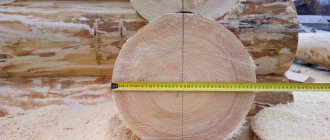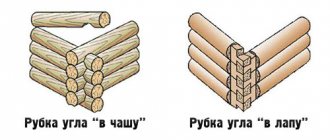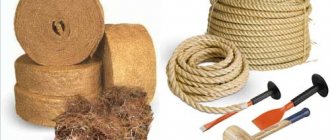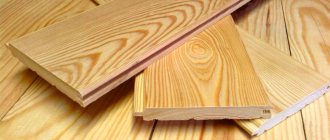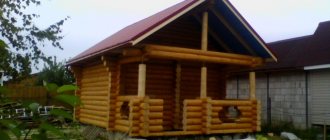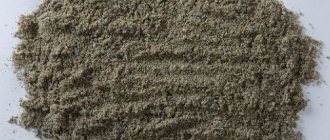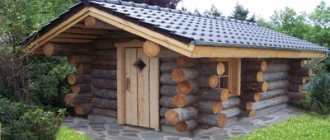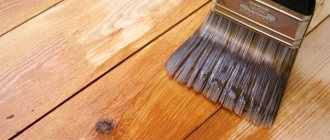And we ourselves believe that a good owner will definitely consider it necessary to delve into the subject, learn more about the material itself - which log is better for a bathhouse, what size, diameter, how they differ, what properties they have. This knowledge will be useful both in order to understand what construction is being made of and to control some parameters or processes. And after that, too - the log house is not to say that it is capricious, but it still requires care.
So let’s figure it all out, and at the same time, you’ll see, we’ll dispel some myths.
Advantages and disadvantages
Any wooden house is good for its light weight and environmental friendliness. A log building has its own characteristics. In what ways is a log inferior to timber?
- The log is less technologically advanced, the stand made from it is more difficult and slower;
- When such a bathhouse (log house) is built, the layout is adjusted to the length of the log;
- At the junction of the crowns, the thickness of the wall is equal to the width of the groove and, accordingly, approximately half the diameter of the log. This negatively affects heat retention in the room.;
Advantages of a log house for a bath:
- The closed joints of the crowns and the external appearance of the log house make it possible to refuse cladding;
- A log, unlike timber, does not have through cracks through the middle.
Log selection
It is best to harvest timber for the bathhouse in winter, from late November to early March, when there is no sap flow.
Summer wood, compared to winter wood, dries out much more, so after shrinkage there will be more cracks and cracks in the log house. In addition, it darkens faster and is more susceptible to fungi and mold. You need to choose a tree that is not affected by rot, fungus and insects, preferably with a minimum number of knots. The trunks should be smooth and not runny, that is, the difference between the diameters of the butt and crown should be no more than 50-70 mm. The most suitable type of wood for a bathhouse is pine, although the lower crown, which is most susceptible to dampness, can be made from larch.
Building area
Ideally, each bathhouse visitor should have from 1.3 to one and a half square meters of space in the dressing room or 1 m2 in the steam room. The optimal washing area for one person is 2.25-2.4 sq.m. More than 80 cm of free space should be left between the shower stall (or a bench in a soap room, the dimensions of the bench are 0.5 x 0.9 meters) for ease of movement. In fact, this area can be slightly increased for greater comfort.
The optimal usable area of a bathhouse for 2-3 people with three rooms (shower room, dressing room and the steam room itself with an area ratio of 1.5: 2: 1) is approximately 10 square meters.
How do you know if the planned area will be enough for you? The easiest way is to outline all the walls and partitions in steps. In winter, it is better to do this in the snow, and in summer, mark with sand or pull ropes.
“Tread down” the dimensions of the future bathhouse on the snow
Stage 9. Roof
As soon as the tree shrinks, you can begin building the roof. If you do this earlier, the roof will simply collapse.
Step 1. Place wooden beams on the wall framing (we have already talked about this).
Step 2. Fix the beams and attach the rafter legs to them in 1 m increments. In the ridge part, cut the rafters at the appropriate angle for the connection.
Step 3. Nail a solid board deck to the rafters (if you plan to use rolled roofing material) or make a sheathing (if you use slate, tiles, etc.).
Step 4. Install the roofing according to the instructions for the specific material.
Step 5. Cover the ridge with galvanized sheet steel to protect it from aggressive environmental influences.
Step 6. Cover the roof gables with siding or clapboard.
After this, proceed to further planned work - pouring a concrete screed or building a wooden floor (in the second case, the logs are cut into the logs of the second crown and fixed), install insulation, carry out interior finishing and arrangement of the steam room according to your project.
Shrinkage
When freshly cut, wood contains a significant amount of moisture. Free moisture is found in wood cavities. Leaving the material, it does not affect its shape and linear dimensions. Bound moisture is another matter - that which is present in the thickness of the cell membranes. Its content in wood reaches up to 30% and removal entails warping, cracking and shrinkage (reduction in linear dimensions) of the timber.
During construction, you will have to add 5–7 cm for each meter of height to the expected height of the bathhouse from the log house. The allowance for sedimentary deformation is also included in the height of door and window openings. The gap above the box is temporarily filled with insulation, and after two years it is caulked or covered with an additional element (if the shrinkage turned out to be less than expected).
Installation of internal partitions (non-shrinkable) and cladding are timely only one to two years after the construction of the log bathhouse for shrinkage from logs. The period of “rest” depends on the size of the log house and the weather.
For a small bathhouse, 10–11 months of settling may be enough - if construction began after the autumn rains and the summer was dry.
Attention! The gap between the partition and the ceiling is required even after drying, at least 1-2 centimeters. Horizontal shrinkage - along the wood fibers - is only a few tenths of a percent, so when building a log bathhouse, no attention is paid to shrinkage along the length
Horizontal shrinkage - along the wood fibers - is only a few tenths of a percent, so when building a log bathhouse, no attention is paid to lengthwise shrinkage.
A bathhouse can be built from brick, but many people see a log house as a “historically correct” solution.
If you say the word “bathhouse”, then most likely an image of a log house will appear.
In order for log houses and bathhouses to serve for a long time, the work of professional carpenters, assemblers, roofers, healthy timber and their competent processing are needed. Proper use will prevent early cracking and twisting of the wood.
Shrinkage
When freshly cut, wood contains a significant amount of moisture. Free moisture is found in wood cavities. Leaving the material, it does not affect its shape and linear dimensions. Bound moisture is another matter - that which is present in the thickness of the cell membranes. Its content in wood reaches up to 30% and removal entails warping, cracking and shrinkage (reduction in linear dimensions) of the timber.
During construction, you will have to add 5–7 cm for each meter of height to the expected height of the bathhouse from the log house. The allowance for sedimentary deformation is also included in the height of door and window openings. The gap above the box is temporarily filled with insulation, and after two years it is caulked or covered with an additional element (if the shrinkage turned out to be less than expected).
Installation of internal partitions (non-shrinkable) and cladding are timely only one to two years after the construction of the log bathhouse for shrinkage from logs. The period of “rest” depends on the size of the log house and the weather.
For a small bathhouse, 10–11 months of settling may be enough - if construction began after the autumn rains and the summer was dry.
Attention! The gap between the partition and the ceiling is required even after drying, at least 1-2 centimeters.
Horizontal shrinkage - along the wood fibers - is only a few tenths of a percent, so when building a log bathhouse, no attention is paid to lengthwise shrinkage.
A bathhouse can be built from brick, but many people see a log house as a “historically correct” solution.
If you say the word “bathhouse”, then most likely an image of a log house will appear.
In order for log houses and bathhouses to serve for a long time, the work of professional carpenters, assemblers, roofers, healthy timber and their competent processing are needed. Proper use will prevent early cracking and twisting of the wood.
Bathhouse made of large logs
One of the possible options for constructing a bathhouse box is to use debarked and ground blanks of large diameter. If you build walls from Siberian pine or cedar, and their diameter often reaches 50-60 cm, the result will be a very warm and, most importantly, durable room. On average, hand-cut bathhouses made from large logs last for 40-50 years, no less.
The large size of the workpiece gives the bath an unusual look
For steam rooms and saunas in Arctic cold conditions, log houses are built from large-diameter logs, most often the famous Canadian red cedar. The diameter of the chopped log can reach 110-140 cm, resulting in a very warm room, but such baths are recommended to be built for dry and very cold climates, otherwise the outer surface of the walls will quickly become covered with cracks due to fluctuations in air humidity.
Log houses made from large logs require the use of construction equipment
Log houses are assembled by cutting the corners “into the bowl”, this is due to the high cost of the logs and the desire of the builders to save material as much as possible; sometimes the root parts are not even cut off.
Is calibrated wood suitable for construction?
The opinions of owners and builders are divided into two categories: some believe that wood should not be used as a building material for a sauna, since moist air always circulates inside the steam room. This breaks down the wood and reduces its shelf life by exposing it to rot and insects.
On the other hand, the owners of such saunas claim that you can experience the whole essence of a Russian bath only in a steam room built from logs.
Article on the topic: How to hold a corporate party in a sauna
You need to figure out
when it’s still worth building a bathhouse from cylinders:
- if all buildings on the site are already made of this material;
- if you don’t want to build a massive foundation for the structure;
- if the region has a favorable climate for using logs;
- if construction time is limited.
It will be beautiful if all the buildings on the site - the house, barn and garage - are already made of cylindrical logs. Then a bathhouse in exactly the same style will only complement this ensemble.
If there are differences in the area, then you can build a strip foundation , having previously strengthened it with a retaining wall. This allows you to save money on a massive base and not wait for long shrinkage. The strip base should stand for 1 month to dry completely, after which the steam room can be erected.
Is the region's weather and average annual temperature warm? Then you can safely build a bathhouse from cylinders. Such a climate will not have a significant negative impact on the material for work. In addition, when choosing a rounded log, you should understand that the construction time of the structure will be short.
If you plan to add a bathhouse to a stone house, then you should carefully consider this decision in terms of safety and aesthetics.
Types of buildings from it
From the specified material you can build the following types of baths:
- with attic;
- with covered veranda;
- with an open porch;
- with a large lounge on the second floor;
- with a terrace.
Rounding is a material from which any structure can be built - everything is limited by the owner’s imagination. The attic is an excellent option if the sauna is of a small area. On the attic floor you can place a billiard table or a bedroom. The attic can serve as a full-fledged large recreation room, where you can build a balcony.
There are many options and varieties, for example, a bathhouse with a veranda or terrace, as well as a porch. These extra spaces can be used in practical ways. Here you can place a table and furniture where you can relax after bath procedures.
In some projects you can find a bathhouse made of rounded logs, and a terrace made of chopped logs. In construction, a combination of these two materials is allowed; in fact, it looks very beautiful.
What determines the size of the bath
The first thing that determines the size of the bathhouse is whether it is free-standing or serves as an extension to the house. In the second case, one of the walls of the house will turn into a partition between the bathhouse and the main building.
One of the extension options
Bathhouse attached to a house made of rounded logs
Also, the size of the bath depends on the size of the site and the amount of free space. It is irrational to build a 12x12 meter bathhouse on six acres. And, on the contrary, on a plot of a couple of hectares you can safely locate a bathhouse complex of any size.
It is worth choosing the size of the bathhouse according to the number of visitors. If you plan to go to the steam room in splendid isolation, then a modest building of 2x3 or 3x4 meters will be more than enough. For a large family, it is better to choose a larger size, from 6x6 m to 6x12 or more, of course, if you do not plan to take turns occupying the steam room.
Bathhouse project 2x3 m
Bathhouse 2x3 m, project
It is better to choose the dimensions of the steam room based on your preferences - whether you like to steam while sitting or lying down, sitting on a shelf with your knees bent, or lying stretched out to your full height. But do not rush to build a steam room of immense area, so as not to spend too much time and resources on heating.
Schemes for placing visitors in the steam room
Table. Minimum dimensions of a bathhouse and rooms in it for 1-2 people when seated
| Premises | One man | Two people |
| Steam room area, m2 | 0,98 | 0,98 |
| Recommended steam room dimensions, cm | 850x1150 | 850x1150 |
| Waiting room area, m2 | Waiting room area, m2 | 2,15 |
| Recommended dressing room dimensions, cm | 1000x2150 | 1000x2600 |
| Washing area, m2 | 1,49 | 1,67 |
| Recommended washing area dimensions, cm | 1150x1300 | 1150x1450 |
| Total bath area, m2 | 4,62 | 5,59 |
| Minimum dimensions, cm | 2150x2150 | 2150x2600 |
Table. Minimum dimensions of a bathhouse and rooms in it for 2-4 people when placed lying down
| Premises | 2-3 people | 2-3 people | 3 people | 4 people |
| Steam room area, m2 | 2,34 | 2,34 | 2,7 | 3,0 |
| Recommended steam room dimensions, cm | 1300x1800 | 1300x1800 | 1400x1800 | 1500x2000 |
| Waiting room area, m2 | 4,03 | 4,03 | 5,4 | 5,4 |
| Recommended dressing room dimensions, cm | 1300x3100 | 1400x3400 | 1500x3600 | 1800x3600 |
| Washing area, m2 | 3,24 | 3,6 | 3,78 | 4,2 |
| Recommended washing area dimensions, cm | 1800x1800 | 1800x1800 | 1800x2100 | 2000x2100 |
| Total bath area, m2 | 9,61 | 10,88 | 10,88 | 11,88 |
| Minimum dimensions, cm | 3100x3100 | 3200x3400 | 3300x3600 | 3600x3800 |
You can refer to GOST 52493-2005, which regulates the operation of baths and showers. But this set of rules was developed for public baths, and therefore for an individual builder it is only advisory. Paragraph 5 of GOST states that the dimensions of the bathhouse itself and the premises in it may vary depending on the climatic conditions of the area and national traditions.
Bake
Stone stoves are used to heat the bathhouse and heat the water. In such furnaces, fairly large natural stones (boulders, pebbles, granite) serve as heat accumulators, which are heated by hot gases coming out of the firebox. Stones are taken at the rate of 60 kg per 1 m³ of steam room, sometimes adding up to 20% pig iron. The stove is positioned so that the steam room, washing room and dressing room are heated simultaneously (but, of course, in different modes).
The stove-heater is made of refractory or ordinary red brick in clay mortar with the addition of fireclay sand or crushed refractory brick. To make a firebox, approximately 150-200 bricks, 20-27 kg of clay, 20-27 kg of fireclay sand are consumed.
The height of the firebox, counting from the bottom of the boiler, must be at least 50 cm so that the required amount of fuel can be placed.
When making a stove, it is necessary to ensure that there is a space of 4-5 cm between the walls of the stove and the boiler, then hot gases wash the boiler from all sides and heat the water faster. The draft in furnaces depends on the height of the pipe and other data. The pipe near the attic floor must have a groove or fluff 38 cm thick, counting from smoke. The roof sheathing and rafters should not reach 15 cm from the pipe (this gap can be closed with roofing steel, slate, or tiles).
2007, Dobrosrub
Methods for assembling logs into a log house
An example of cutting into a thicket with your own hands during the assembly of a log bathhouse
The logs need to be connected using one method, either in a paw or in a lock. You should not take logs that are shorter than the wall of the bathhouse. Each joint is an additional loss of heat, and this is unacceptable in a bathhouse.
The logs are assembled using metal brackets, wooden dowels or using rectangular wedges. Rectangular wedges are the most labor-intensive method, but one of the best in terms of strength. To do this, wooden blocks measuring 10–15 cm in length, 5–7 cm in width, and 3–5 cm in thickness are made. Grooves are cut into the log on both sides to suit the size. The block is driven into the lower log with a hammer, and the upper one is put on it.
We have already talked about how to connect logs using dowels (). Iron elements for joining wooden parts are not recommended. When drying, the logs may crack and the glands will be visible, and this is unsightly.
When assembling a log house, window and door openings are cut out in half. It is worth leaving a couple of connecting links; they will hold the geometry of the log house for the bathhouse during shrinkage.
Useful tips
In order for the bathhouse to be in working order for a long time, you need to know the subtleties when building a structure:
- Logs for the log house are harvested in winter. This is necessary because during winter harvesting the log undergoes less rotting and is resistant to various precipitation. To check whether the logs were harvested in winter, iodine is dripped onto them. A bluish spot should form.
- To ensure that the building lasts as long as possible, all wooden structural elements are treated with an antiseptic.
- To increase the thermal capacity of the structure and give it a beautiful appearance, it is necessary to fill all joints and gaps with tow. It should not protrude further than the logs, otherwise it will get wet and rot.
- If you choose the “foot-to-foot” method of fastening logs, it is necessary to protect the corner joints. To do this, they are sheathed with boards.
- It should be remembered that during shrinkage, the height of the building will decrease by 5 or 10 percent.
- Cutting the material to the center will help prevent cracks from appearing in the log.
- Caulk work is carried out in dry weather.
- They increase the stability of the structure and prevent the displacement of logs by securing them with dowels, installed in holes in the center of the logs.
Thus, making a log house with your own hands, although a complex process, is doable. In the video presented for this article you can find complete information on this topic.
Height of rooms in the bathhouse
A prerequisite is that there must be a threshold before entering the steam room, or the level of the entire floor of the steam room should be 10-15 cm higher than the floor level in the washing room or rest room. In the washing room, it is recommended to make the floors 3 cm lower than the level of the finished coating in the rest room.
Threshold
There is a tradition according to which the ceiling height is chosen. Measure the height of the tallest member of the family and make a reserve so that it is convenient to wave the bath broom. The result is from two to two and a half meters. The optimal ceiling height is 210 centimeters.
Steaming should be comfortable
If you make the ceiling too high, it will be very comfortable to sit on the top shelf and steam, but the volume of the steam room will increase, and this will lead to unnecessary fuel consumption for heating the room.
Options for accommodating people in the steam room
If you want to sit on the top shelf, then take a distance from it to the ceiling of 100 cm. For a “lying” position, fifty centimeters is enough, but it may be too hot, because the temperature distribution in the steam room is not uniform:
- the floor is at its lowest temperature;
- every 30 centimeters the temperature rises by about 10°C.
Thermometer in the steam room
The main thing is that the top shelf is higher than the stones in the stove (the heater is usually located one meter from the floor), then the atmosphere will be the best.
There are standards for the location of windows in a bathhouse:
- the bottom of the window opening should not be less than 120 cm from the finished floor line;
- in showers and soap rooms this value is one and a half meters.
Windows in the bathhouse
Doors
Doors are made on dowels from thick tongue-and-groove boards or from boards with selected quarters. The door dimensions should be 5 mm less than the distance between the side folds (quarters). If the doors fit tightly into the quarters of the frame, then, swelling from water and steam, they may jam. In the steam room and washing room, their width should not exceed 70-75 cm. The height of the doors, as a rule, is 160-170 cm. It is recommended to make the threshold high - 25-30 cm from the floor. This is somewhat inconvenient, but it retains heat better, especially at floor level.
What should be the thickness of the walls?
The thickness of the log for the log house depends on how the building is intended to be used: for permanent or temporary residence. In addition, this parameter depends on the climatic conditions of the region: in severe frosts, a log that is too thin will freeze, and a large amount of fuel will have to be spent for heating. The thickness of the log walls for central Russia is determined as follows:
Logs less than 18 cm thick can only be used for non-residential structures. These are gazebos, workshops, outbuildings.
- A country house can be built from logs 20-22 cm thick. Such a building will be designed for summer living, in addition, it will be comfortable in spring and autumn with proper insulation.
- The thickness of a log house for permanent residence is 22-30 cm. This is a fairly expensive solution, but purchasing logs at a high price will allow you to save on purchasing fuel for heating in the future.
- A log 30-40 cm thick is the most reliable, warm and durable option, which, however, will be very expensive. However, you need to take into account that less logs will be required for the construction of walls due to the increased thickness, so the difference in price will be less significant.
If finances allow, you can build a building from thicker material. Economically, this is not the most profitable solution, but the house will be truly strong and as durable as possible.
In addition, a building made of thick logs looks very beautiful: it is a powerful structure that will become a real fortress and can last for many years. The large thickness of the log house also allows you to save on insulation work, since the material itself retains heat well.
If you want to build a log house, the thickness of the walls is not the only parameter that directly affects the energy efficiency of the building
Most of the heat escapes through the openings of doors and windows, so it is important to take care of the correct installation of window and door units. If a large glazing area is expected, you will have to purchase two- and three-chamber double-glazed windows, and all seams in any case will need to be carefully closed and insulated
What should a log bathhouse look like?
A special question is: what should be the thickness of a log house for a bathhouse? This room should be warm, since both the comfort and benefits of bath procedures will depend on this. At the same time, the bathhouse is not used constantly, and some do not use it at all in winter, so it is not advisable to spend too much on purchasing lumber.
For the conditions of central Russia, the optimal thickness of the walls of a log bathhouse is 20-25 cm. This will be enough to maintain a comfortable atmosphere inside the bathhouse, while the material is sold at an affordable price. In any case, when building a bathhouse, you will have to spend money on the purchase of insulation: it is necessary to lay inter-crown rolled material when constructing the walls, in addition, the ceiling and floor require mandatory insulation.
Savings when buying logs for a log house leads to the fact that in the future you will have to constantly spend money on energy resources: the bathhouse will have to be heated for a very long time, and it will begin to cool down very quickly. All this will lead to an insufficient level of comfort, and the building will require additional insulation.
Materials
When deciding to build a log bathhouse, you need to take into account several factors, the first of which is the difference in materials
Chopped or planed logs (they are also called debarked logs) are an ordinary oval-shaped log house, all processing of which was carried out by hand. The top layer of wood, called sapwood, is carefully removed. The result is logs of different sizes, slightly knotty and rough to the touch. Due to the fact that the wood is not sanded and, roughly speaking, remains in its original form, it retains the ability to resist various kinds of negative influences that can be exerted on it not only from inside the bathhouse, but also from the external environment. Since logs have different diameters, it is quite difficult to achieve good thermal insulation: you must have experience working with this material. In addition, chopped logs are cheaper.
A rounded or calibrated log has a higher cost and a completely different appearance. The logs here are processed on a special machine, which makes them all equally round, even and beautiful. The result is a smooth surface without a single roughness. However, along with its original appearance, the tree also loses a good half of all its qualities during such processing. The forest becomes more sensitive to external influences as it loses much of its resilience. However, craftsmen have found a solution to this problem: they repeatedly treat the wood with various impregnations and antiseptics, and as a result, rounded wood becomes more stable.
Solid wood buildings are popular, but you need to know which solid wood to choose.
The following breeds are optimal:
- spruce;
- pine;
- larch;
- oak;
- birch and others.
All of these options are dense and hard enough to withstand constant exposure to hot temperatures and steam. It is best to purchase timber brought from the northern regions. Wood from the Pskov region is most respected and in demand.
It is also necessary to pay attention to the time of purchase: it is best if the wood was harvested in winter. Try not to choose logs that are too thick, as they will crack more quickly than others.
It is worth giving preference to young trees of medium diameter.
After purchasing timber, you need to carefully prepare for subsequent construction. You need to let the log house sit for at least a month. Logs are stacked. It is necessary to leave a ventilation gap of 5 cm between them so that the material can “breathe”. Only after the log house has been “rested” can construction begin.
Selecting and preparing material is an important step towards building a bathhouse. Don't try to save money by choosing low quality wood. The walls of the bathhouse may crack, and the thermal insulation properties may be below average. To play it safe, buy high-quality timber cut down in winter and supplied from the northern regions.
Features of constructing a bathhouse from rounded logs
The construction of bathhouses from rounded logs is much faster and easier, since the products are manufactured in a factory, where they are given a certain shape and size. All of them are numbered and have grooves for easier installation.
However, you should know that products are produced for certain bathhouse projects made of rounded logs, which are presented in the catalogs of woodworking enterprises. From the options presented, you can select the most suitable one and place an order for the manufacture of products. After receiving the kit, there will be no problems assembling the bathhouse. Detailed instructions are also included with the log house.
When building a bathhouse from rounded logs, certain requirements must be observed:
- for better contact with the foundation, the casing crown should be trimmed from the bottom side;
- since the logs lost their protective layer during processing, all products must be impregnated with a fire-retardant agent;
- For vertical stability of the structure, it is necessary to connect the logs with dowels made of hard wood of oak, beech or birch, which are recessed into the product by at least 3 cm;
- holes for dowels should alternate in a checkerboard pattern along the entire length and height of the wall in increments of 0.8-1.2 m and a length of 2-3 crowns;
The rounded log has undergone mechanical processing in production and therefore has the same diameter along its length, as well as ready-made grooves, which greatly facilitates the construction of a bathhouse
- before drilling holes for the dowels, the logs should be secured using temporary nails, which are removed after connection;
- Between the products, heat-insulating material in the form of tow or flax fiber must be placed, which is secured with staples;
- the construction of each subsequent crown must be controlled using a level to avoid distortion of the frame;
- to prevent the destruction of door and window frames during shrinkage of the log house, the openings are framed with casing beams with a gap of 3% of the height of the opening, which is filled with insulation.
Special cases
It probably remains to clarify a couple of points related to special cases - what material is suitable for a log bathhouse with a second floor, and are there log barrel bathhouses?
For a bathhouse with a second floor
A two-story wooden bathhouse is often built from logs with a diameter of 20 to 28 cm . We came to this conclusion after reviewing the proposals of a variety of construction companies that build such turnkey baths. However, the customer is sometimes given the opportunity to choose the diameter of the logs himself.
From this we can conclude that no special requirements for the thickness of logs are provided in the case of a two-story building, but the foundation must be appropriate for the future load. A civil engineer must calculate the foundation.
For a barrel bath
Let's say right away: a log is not used for a barrel bath . In all the options that we saw, it was an edged board. As an option - edged tongue and groove.
Barrel baths arose as a type of mobile baths, which were also relatively cheap. It is logical that neither in design, nor in purpose, nor in price, solid logs are suitable as wall material here.
But if any of the readers have seen something that proves the opposite, we will be glad to see the proof link

